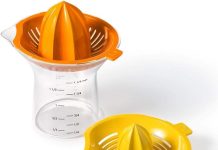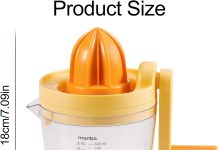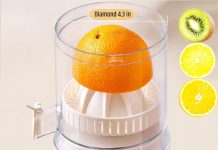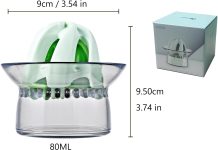Let’s talk about juicing and whether it’s really a waste of fruit. Many of us have tried juicing as a way to incorporate more fruits into our diets and enjoy their nutritional benefits. Yet, some argue that juicing removes essential fibers and antioxidants, making it less beneficial than eating whole fruits. In this article, we will explore the pros and cons of juicing, debunk some common myths, and help you make an informed decision about including juicing in your daily routine. Stick around to find out if juicing is truly a waste of fruit or a wholesome addition to a healthy lifestyle.
Review contents
The controversy surrounding juicing
The rise in popularity of juicing
In recent years, juicing has skyrocketed in popularity as a way to quickly and easily consume a variety of fruits and vegetables. Juicing machines and pre-packaged juice cleanses have become a common sight in kitchens and grocery store aisles. This surge in popularity can be attributed to the perceived health benefits and the convenience that juicing offers. However, along with its rise in popularity, juicing has also sparked controversy and raised concerns among health experts and environmentalists alike.
The concerns about nutrient loss
One of the main concerns surrounding juicing is the potential loss of nutrients during the extraction process. When fruits and vegetables are juiced, the natural fiber is often removed, leaving behind a concentrated liquid. While this liquid may still contain some vitamins and minerals, it lacks the fiber that is essential for a healthy digestive system. Fiber helps regulate blood sugar levels, promotes satiety, and contributes to overall gut health. Without fiber, the body may not receive the full nutritional benefits of the fruits and vegetables being juiced.
The environmental impact of juicing
Another point of contention when it comes to juicing is its impact on the environment. The volume of fruits and vegetables required to produce a single glass of juice is often staggering. This demand for large quantities of produce can put strain on the agricultural industry and lead to unsustainable farming practices. Additionally, the juicing process often produces a significant amount of waste in the form of pulp and discarded peels. This waste not only contributes to landfill accumulation but also requires energy-intensive waste management processes.
The argument for minimizing food waste
One argument in favor of juicing is its potential to minimize food waste. In many households, fruits and vegetables that are nearing their expiration date or have slight imperfections often end up in the trash. By juicing these fruits and vegetables, consumers can salvage them and avoid contributing to the growing food waste problem. Additionally, leftover pulp from the juicing process can be repurposed in creative ways, such as adding it to baked goods or using it as garden compost. Juicing can be seen as a way to make the most out of the produce we have and reduce unnecessary waste.
The process of juicing
Different juicing methods
There are various methods of juicing, each with its own pros and cons. Centrifugal juicers, for example, use high-speed blades to extract juice quickly but may introduce more oxidation and heat, which can potentially degrade nutrients. On the other hand, masticating juicers or cold-press juicers operate at slower speeds, reducing heat and oxidation and potentially preserving more nutrients. It is essential to choose a juicing method that aligns with your priorities regarding nutrient retention and taste.
Benefits of juicing
One of the main benefits of juicing is the ability to consume a large quantity of fruits and vegetables in a convenient and easily digestible form. Juicing can be a great way to introduce a variety of produce into your diet and increase your intake of essential nutrients. Additionally, the liquid form of juice allows for quick absorption of nutrients into the bloodstream, providing a quick boost of energy and potential health benefits.
Drawbacks of juicing
While juicing offers several benefits, it also has some drawbacks to consider. As previously mentioned, juicing removes the natural fiber found in fruits and vegetables. This can lead to increased blood sugar spikes and a lack of satiety, as fiber plays a crucial role in slowing down digestion and keeping you feeling full. Additionally, the process of juicing can be time-consuming and messy, requiring extensive preparation and clean-up.
Nutrient loss in juicing
The impact of oxidation
Oxidation is one of the primary causes of nutrient loss during the juicing process. When fruits and vegetables are exposed to air, enzymes called oxidases are activated, causing the breakdown of certain vitamins and minerals. High-speed juicers, which introduce more air into the juicing process, can accelerate this oxidation. To minimize nutrient loss, opting for low-speed juicers or cold-press juicers is recommended, as they generate less heat and air.
Effects on fiber content
The removal of fiber during the juicing process can have significant implications for digestion and overall health. Dietary fiber is essential for maintaining a healthy gut, regulating blood sugar levels, and supporting weight management. Without sufficient fiber intake, individuals may experience increased blood sugar spikes, decreased satiety, and potential digestive issues.
Vitamin and mineral degradation
While juicing can provide a concentrated source of vitamins and minerals, the extraction process can also lead to some nutrient degradation. Heat and oxidation can break down certain vitamins, such as vitamin C, and minerals may be lost in the discarded pulp. To minimize nutrient degradation, it is crucial to consume freshly pressed juice immediately after preparation and store any leftovers in airtight containers in the refrigerator.
Maximizing nutrient retention in juicing
Using low-speed juicers
To maximize nutrient retention in juicing, opting for low-speed juicers or cold-press juicers is recommended. These juicers operate at slower speeds, generating less heat and oxidation, which can help preserve the integrity of vitamins and minerals in the juice. By using a low-speed juicer, you can ensure that you are getting the most out of the fruits and vegetables you are juicing.
Immediate consumption
Another way to maximize nutrient retention is to consume freshly pressed juice immediately after preparation. Exposure to air and light can accelerate the degradation of vitamins and minerals, so it is best to drink the juice soon after juicing. If you need to store juice for later consumption, using airtight containers and keeping it refrigerated can help slow down nutrient degradation.
Adding pulp back into the juice
To increase fiber content, consider adding some of the pulp back into the juice. While juicing removes a significant portion of the fiber, incorporating a small amount of pulp can help reintroduce some of these essential dietary fibers back into the juice. This can aid digestion, regulate blood sugar levels, and provide a greater sense of satiety.
Blending vs. juicing
Blending and juicing are two different methods of extracting nutrients from fruits and vegetables. While juicing separates the liquid and fiber, blending incorporates the whole fruit or vegetable, including the fiber. Blending can be a preferable option for those looking to maximize fiber intake and maintain the benefits of whole foods. However, juicing may still be preferred for individuals who have difficulty digesting fiber or want a quick and convenient way to consume a variety of produce.
The environmental impact of juicing
The volume of fruits required
One of the significant environmental concerns with juicing is the sheer volume of fruits and vegetables required to produce a single glass of juice. The high demand for produce can lead to unsustainable farming practices, excessive water usage, and deforestation. It is essential to consider the environmental impact of juicing and opt for sustainable farming practices, such as choosing organic and locally sourced produce.
Waste management concerns
The juicing process often generates a significant amount of waste in the form of discarded pulp, peels, and packaging. This waste requires proper disposal and can contribute to landfill accumulation. To mitigate waste management concerns, individuals can explore creative uses for the remnants of juicing, such as repurposing pulp in recipes or donating it to composting initiatives.
Energy consumption
Juicing machines require energy to operate, and the high-speed juicers often consume more energy compared to low-speed or manual juicers. It is important to be mindful of energy consumption and opt for energy-efficient appliances when possible. Additionally, practicing energy-saving habits such as juicing in bulk and unplugging the machine when not in use can further reduce energy consumption.
Packaging and plastic waste
Pre-packaged juices and juice cleanses often come in single-use plastic bottles or pouches, contributing to the global plastic pollution problem. Choosing fresh, local produce and juicing at home can help reduce the reliance on single-use packaging. Alternatively, individuals can opt for reusable glass bottles or seek out juice brands that prioritize sustainability by using recycled and recyclable packaging materials.
The case against juicing
Wasted fiber
One of the main arguments against juicing is the removal of natural fiber. Fiber plays a vital role in gut health, digestion, and maintaining a feeling of fullness. By juicing and discarding the fiber, individuals may miss out on these essential benefits. Consuming whole fruits and vegetables, or opting for blending methods that include the fiber, can be a better way to ensure adequate fiber intake.
Disruption of satiety signals
The lack of fiber in juiced fruits and vegetables can disrupt satiety signals, potentially leading to overconsumption of calories. Fiber helps slow down digestion, promoting a feeling of fullness and regulating appetite. Without this fiber, individuals may not feel as satisfied and may consume more juice or other foods, increasing their overall caloric intake.
Added sugar consumption
Juices, even when freshly pressed, can still contain a significant amount of natural sugars from the fruits and vegetables. While these sugars are naturally occurring, consuming large quantities of juice can lead to an increased intake of sugar. Excessive sugar consumption has been linked to various health problems, including obesity, diabetes, and tooth decay. It is important to moderate juice consumption and balance it with a variety of other nutrient-dense foods.
Liquid calories
Calories consumed in liquid form, such as through juicing, may not provide the same level of satiety as calories consumed in solid form. The body may not register liquid calories in the same way, potentially leading to overeating or consuming excess calories. It is important to be mindful of overall calorie intake and consider the potential effects of liquid calories when incorporating juicing into a balanced diet.
Finding a balance
Incorporating whole fruits and vegetables
While juicing can be a convenient way to consume fruits and vegetables, it is important to also incorporate whole produce into your diet. Whole fruits and vegetables provide the necessary fiber and nutrients that may be lost during juicing. By consuming a variety of whole foods, individuals can ensure a well-rounded and balanced diet.
Using the remaining pulp
To minimize waste and maximize nutrient intake, consider finding creative uses for the remaining pulp. Pulp can be added to baked goods, used as a base for vegetable patties, or mixed into soups and stews to add an extra dose of fiber and nutrients. Repurposing pulp can help minimize food waste and enhance the nutritional value of meals.
Limiting juicing frequency
While juicing can be a useful tool to increase fruit and vegetable consumption, it is important not to rely solely on juicing as a source of nutrients. Moderation is key, and individuals should aim to consume a variety of whole fruits and vegetables in addition to incorporating juiced options. This can help maintain a balanced diet and ensure an adequate intake of fiber and other essential nutrients.
Considering individual health goals
When deciding whether to include juicing in your diet, it is essential to consider your individual health goals and needs. If you have specific dietary restrictions, health conditions, or goals, consulting with a healthcare professional or registered dietitian can provide guidance on the most suitable approach. Everyone’s nutritional needs are different, and finding a balance that works for you is crucial.
The role of juicing in food waste reduction
Utilizing imperfect fruits
Juicing can play a role in reducing food waste by utilizing fruits and vegetables that are nearing their expiration date or have imperfections. Rather than allowing these produce items to go to waste or be thrown out, juicing them can salvage their nutrients and prevent unnecessary discards. By incorporating imperfect fruits into your juicing routine, you can contribute to reducing food waste.
Reducing discards from juicing process
During the juicing process, a significant amount of pulp and peels are often discarded. However, these remnants can still have nutritional value and be repurposed in various ways. Take the discarded pulp and add it to baking recipes, use it as a thickening agent in soups or sauces, or mix it into homemade granola or smoothie bowls. By finding creative uses for these typically discarded parts, you can minimize waste and maximize the nutritional potential of your ingredients.
Creative uses for juice remnants
In addition to repurposing the pulp, other remnants of the juicing process, such as the juice remnants and strained fibers, can be used creatively. The juice can be used as a base for homemade popsicles, added to sauces or dressings, or used to flavor other beverages or smoothies. The strained fibers can be used as a natural exfoliant in DIY skincare products or mixed into soil to enrich compost.
Donating leftover pulp
If you find yourself with excess pulp that you are unable to repurpose, consider donating it to local farmers, community gardens, or animal sanctuaries. Farmers may use it as animal feed or compost, while community gardens can utilize it to enrich their soil and promote sustainable gardening practices. Donating leftover pulp not only reduces waste but also supports local initiatives and contributes to a more sustainable food system.
Alternatives to juicing
Consuming whole fruits and vegetables
While juicing offers convenience and a concentrated source of nutrients, consuming whole fruits and vegetables should remain a priority. Whole foods provide the necessary fiber, vitamins, and minerals in their unaltered form and support optimal digestive health. By making whole fruits and vegetables the foundation of your diet, you can reap the benefits of their natural packaging and nutritional composition.
Smoothies as an option
For those who still want the convenience and nutritional benefits of a blended drink, smoothies can be a preferable alternative to juicing. Unlike juicing, blending incorporates the whole fruit or vegetable, including the fiber. This allows for a slower uptake of nutrients, increased satiety, and a balanced release of energy throughout the day. Smoothies can be customized to individual tastes and dietary preferences, making them a versatile and beneficial option.
Other methods of extracting juice
If juicing with traditional juicers does not align with your preferences or needs, consider exploring other methods of extracting juice. Manual juicers, such as citrus presses or wheatgrass juicers, can be more suitable for specific fruits and vegetables and can preserve more nutrients. Additionally, incorporating the use of a blender and straining the mixture can also provide a similar liquid consistency while retaining more fiber and nutrients.
Exploring other food preparation techniques
Juicing is not the only method of preparing fruits and vegetables for consumption. Exploring other food preparation techniques, such as sautéing, steaming, roasting, or grilling, can provide a range of flavors and textures while retaining the nutritional benefits of whole foods. These cooking methods can enhance the taste and enjoyment of fruits and vegetables, allowing for a varied and sustainable approach to incorporating them into your diet.
The final verdict
When it comes to juicing, the final verdict ultimately depends on individual preferences, health goals, and environmental considerations. Juicing can be a convenient way to increase fruit and vegetable intake and enjoy a concentrated source of nutrients. However, it is important to be mindful of potential nutrient loss, environmental impact, and overall dietary balance.
Finding a balance between juicing and consuming whole fruits and vegetables is essential. Incorporating a variety of nutrient-dense foods and exploring alternative food preparation techniques can help ensure a well-rounded and sustainable approach to nutrition. Making informed choices based on individual needs and goals will allow for a healthier and more environmentally conscious lifestyle. So, whether you choose to juice, blend, or enjoy whole fruits and vegetables, the key is to prioritize both personal health and the well-being of the planet.



































